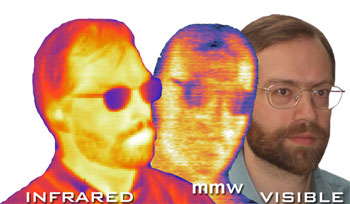
home | Who are we? | Workshop | Resources | Links | Gallery |
| Passive Imaging |
Nearly all objects and materials emit a range of wavelengths of light in a way which depends on their temperature. Objects have to be ‘red hot’ (about 500ºC) before they visibly glow. Objects at room temperature emit most of their heat in the infrared part of the spectrum, but some of the heat is also emitted at longer wavelengths Infrared wavelengths are longer than those of visible light so the image is more coarse - in other words it has less RESOLUTION. The millimetre wave image is even coarser because the wavelength is longer still But you can also see through things with millimetre
waves because they behave more like radio signals. The hair and
beard appear cold in the IR since they are insulating but the millimetre
wave image doesn’t see the hair and beard at all - the heat passes
straight through!
|
'Vision For The Future' is an EPSRC funded project run by the MMW group at the University of St Andrews
Copyright ©2006 by the University of St Andrews :: web, graphic and exhibition design by FifeX Ltd, www.fifex.co.uk
 To
the left you can see three pictures taken with three different types
of camera: visible, infrared and millimetre wave. The infrared and
millimetre wave cameras show heat coming from the body which you
can't see with normal ‘visible’ light
To
the left you can see three pictures taken with three different types
of camera: visible, infrared and millimetre wave. The infrared and
millimetre wave cameras show heat coming from the body which you
can't see with normal ‘visible’ light